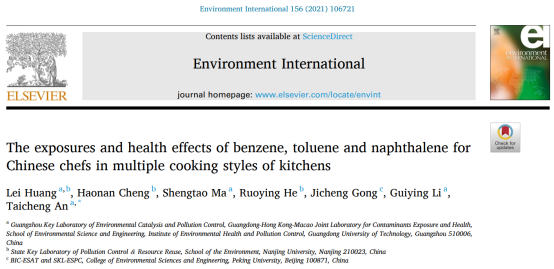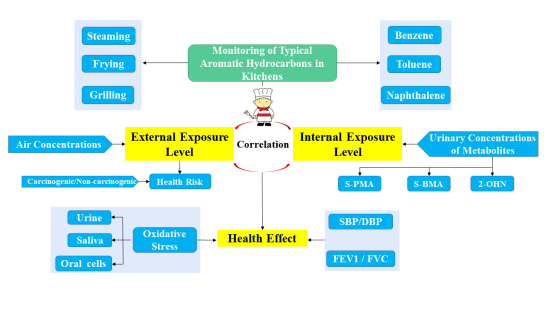近日,基于广州市环境催化与污染控制重点实验室资助下的合作研究项目,广东工业大学环境健康与污染控制研究院、环境科学与工程学院安太成教授团队与南京大学黄蕾教授团队合作的题为《The exposures and health effects of benzene, toluene and naphthalene for Chinese chefs in multiple cooking styles of kitchens》的学术论文在Environment International (2021, 156:106721)杂志上接受发表。论文的第一作者为黄蕾教授,通讯作者为安太成教授。该研究重点关注厨师这一职业暴露人群,选取了三种经典的中式烹饪风格蒸、炸、烤的厨师作为研究对象,对烹饪过程中排放的几种典型芳香烃(苯、甲苯和萘)的外暴露和内暴露水平、健康风险评估和影响等进行了系统分析研究。研究结果为厨师工作环境的职业暴露的健康评估提供数据支撑。

与家庭烹饪相比,商业烹饪工作强度更大、暴露持续时间更长、瞬时排放的烹饪污染物浓度更高,因此研究商业化运作厨房中空气污染物以及不同商业化烹饪风格对厨师的职业暴露与健康影响非常重要。目前关于厨师烹饪暴露的研究大多数研究主要关注厨师暴露的污染物浓度水平或健康指标,尚未发现有将内外暴露的结果相结合去探究厨师健康效应的研究报道。为了更好地了解中式烹饪过程中污染物苯、甲苯和萘的内外暴露水平及其对厨师健康的影响,本研究在中国南京选择了三种经典中式烹饪厨房与相关暴露厨师进行研究。首先我们通过监测厨师暴露在厨房中的污染物浓度,评价了苯、甲苯和萘这三类重要污染物的外暴露情况。其次通过测试其尿液中代谢产物的浓度分析了三种典型芳烃的内部暴露水平。然后评估了内暴露和外暴露水平之间的相互关系。最后研究了三种典型的芳烃暴露对健康的影响,包括对氧化应激、肺功能和血压的影响等。结果表明在不同厨房的空气样本中,萘是浓度最高的污染物,而苯的浓度最低。油炸厨房中的甲苯浓度明显高于蒸式厨房。油炸厨房空气中甲苯浓度、烧烤厨房中苯的浓度均超出国标《室内空气质量标准》(GB/T18883-2002)。关于尿液中污染物的代谢产物,研究发现炒炸式厨房工作厨师的S-苄基巯基酸(S-BMA)-甲苯的内暴露标志物含量显着高于其他烹饪方式的厨师,这与空气中甲苯浓度相对较高的结果是一致的。污染物的内暴露和外暴露之间存在良好的相关性。氧化应激水平受2-羟基萘(2-OHN)和S-BMA的影响,表明这些职业暴露的厨师存在一定的潜在健康风险。综上,本研究认为非常有必要对商业化运行的厨房中典型芳香烃的暴露水平进行系统监测,并调查它们在大规模暴露群体中的可能潜在健康影响,如果有条件,建议改善厨师厨房的工作条件,加强通风。本研究的工作作为一个完整的系统研究,力图通过细分厨师的烹饪类别,以期通过评估烹饪过程中厨师的外暴露和内暴露水平及其相关关联关系,同时研究其对心肺功能和氧化应激水平在内的健康指标的影响,从而探讨对其健康风险的初步评估。未来的相关领域的研究需要进一步探索更为有效的人体检测方法来帮助了解厨师的个体暴露情况,并基于更大的暴露人群样本来开展厨师的24小时暴露跟踪研究,使其暴露计算和健康影响评估更加准确。
DOI:https://doi.org/10.1016/j.envint.2021.106721
Graphical Abstract:

论文英文摘要:
Commercial cooking has higher intensity and more severe instantaneous cooking pollution from volatile organic chemicals compared to home cooking, making health risk assessment of occupational exposure for chefs a priority. In this study, chefs from three cooking styles of kitchens, including steaming, frying, and grilling, were selected to investigate the external and internal exposures, health risks and effects of several typical aromatic hydrocarbons (benzene, toluene and naphthalene). Naphthalene was found to be the most concentrated contaminant in air samples among the different kitchens, while benzene had the lowest concentration. The concentration of toluene in frying kitchens was significantly higher than that in steaming kitchens. Air concentrations of toluene in frying kitchens, as well as benzene concentrations in grilling kitchens exceeded the standard level according to indoor air quality standard (GB/T18883-2002). Regarding the metabolites of pollutants in urine, the content of S-benzylmercapturic acids (S-BMA) for frying chefs was significantly higher than that for other cooking styles of chefs, which was consistent with the relatively higher air concentrations of toluene. There was a good correlation between internal and external exposure of the pollutants. The level of oxidative stress was influenced by 2-hydroxynaphthalene (2-OHN) and S-BMA, indicating the potential health risks of these occupational exposed chefs. This study indicates the need to improve the monitoring of typical aromatic hydrocarbons, as well as to investigate their potential health effects in large-scale groups, and improve the ventilation in kitchens.
项目资助:这项工作得到了国家自然科学基金(41822709)、国家重点研发项目(2019YFC1804001和2019YFC1804503)和广州市环境催化与污染控制重点实验室开放基金项目(GKLECPC-02)的支持。